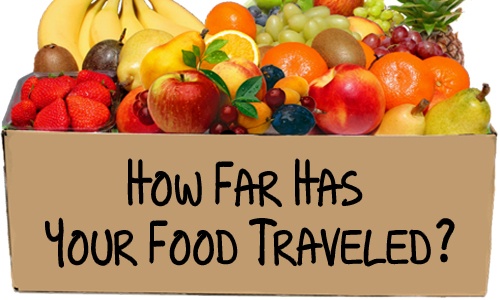Note: This article was originally written for a Canadian publication, but the figures are much the same for U.S. consumption.
Take a look at that luscious, juicy mango on your plate. Your mouth is no doubt watering as you anticipate digging into its sweet ripeness.
But the sweetness of that mango or clementine or strawberry starts to sour a bit when you consider the environmental cost of growing the crop and transporting it to your doorstep.
There have been hardy types who have vowed for health and environmental reasons to restrict their diets to food produced within 100 miles (roughly 166 km) of their homes. Most of them have found this was incredibly difficult and that required a great deal of sacrifice.
What has become commonly known as the 100-mile pledge might be impossible in Vancouver if you want to cook with extra virgin olive oil or you’re craving wild-caught salmon in Saskatoon or oranges when you live in Quebec. And forget about grains entirely if you live in BC. They’re just not grown there.
We’re not talking about Ho-Hos or Ding-Dongs or Tostitos here. We’re talking about real food: apples, potatoes, beef, carrots, onions and lettuce.
Consumers are increasingly asking not only how their food was grown, but where it comes from.
Of course, labeling will usually tell you about produce, but not necessarily about meat and dairy products.
If your supermarket isn’t labeling foods so you know what is local, an easy first step would be asking the manager to do so, suggests Greg Horn, author of Living Green: A Practical Guide to Simple Sustainability (Freedom Press, 2006).
Regardless of the difficulty of the 100-mile pledge today, it’s still a goal worth striving for. “In the long-term,” says Living Green author Horn, “We need to support local agriculture, encourage local farmers and make sure there is a thriving market for their products.”
It stands to reason that food produced near your home will maintain its nutritional value better than that orange that travelled 6,000 miles in the dead of winter.
But think about the carbon footprint of that pineapple from Hawaii or that burger from Argentina.
In 2005, the Region of Waterloo (Ontario) Public Health released some sobering statistics about the real cost of our food.
“The imports of 58 commonly eaten foods travel an average of 2700 miles to the Waterloo Region,” says the report compiled by the Leopold Center for Sustainable Agriculture at Iowa State University. “These imports account for 57,000 tons of GHG (greenhouse gas) emissions annually, contributing to climate change and air quality, which both have an effect on human health.”
And that’s just one small municipality!
More importantly, the Waterloo report includes only foods that can be grown in that region, making the environmental impact even more devastating. The scientists estimated that switching from imports to locally produced foods could save nearly 60,000 tons of greenhouse gas emissions from the truck that bring the foods from faraway producers. That savings would be the equivalent of taking 16,191 cars off the road.
The biggest culprit? Beef, far and away. The average burger or steak travels 3,500 miles to get to Waterloo’s tables.
You might say, “But I’m a vegetarian. Surely the cost of my pears wouldn’t be as high as that!”
You’d be right, but the cost is still enormous. Your pear has traveled more than 3,600 miles to get to your table and the annual greenhouse gas emissions to get it there were the equivalent of removing 1,641 cars from the road, 561 times more than if you’d bought a locally produced fruit that would have more nutrients and probably ripened longer on the tree.
Speaking of vegetarian diets, the environmental impact of meat production in terms of water and land usage far exceeds “cost” of vegetable protein production. It takes about ten grams of grain to produce one gram of meat and requires about 26 times the amount of water.
Dutch research shows that, in general, the carbon footprint of your beef burger is about 25 times that of a soy burger, but there are some variables that may balance out the equation.
When you take into account the long distance air transport, deep freezing and horticultural practices, “Long-distance transported vegetarian foods may actually have a bigger carbon footprint than locally produced organic beef,” says the Dutch study author, Lucas Reijnders of the University of Amsterdam.
Food miles have finally found place on the sustainable living radar screen. You can do you part, not only by buying local, but by choosing foods that have lighter impact and smaller carbon footprints.
You can find an excellent food miles calculator for foods imported to Canada and transported within the country at: http://www.lifecyclesproject.ca/initiatives/food_directory/
There are some who would say that food miles are an oversimplification and remind us to take into account agricultural practices in other countries, efficiency of transportation, etc. One New Zealand study claims that sustainable farming techniques make lamb produced in New Zealand environmentally cheaper than locally grown British lamb, even taking into consideration the 11,000-mile transport.
“My advice to people is to get started somehow,” says Horn. “It’s a continuum of steps between doing nothing and moving onto an organic farm and producing all your food yourself. Neither is very practical in my minds. The best advice is to arm yourself with information and do what you can to make the right choices.”







